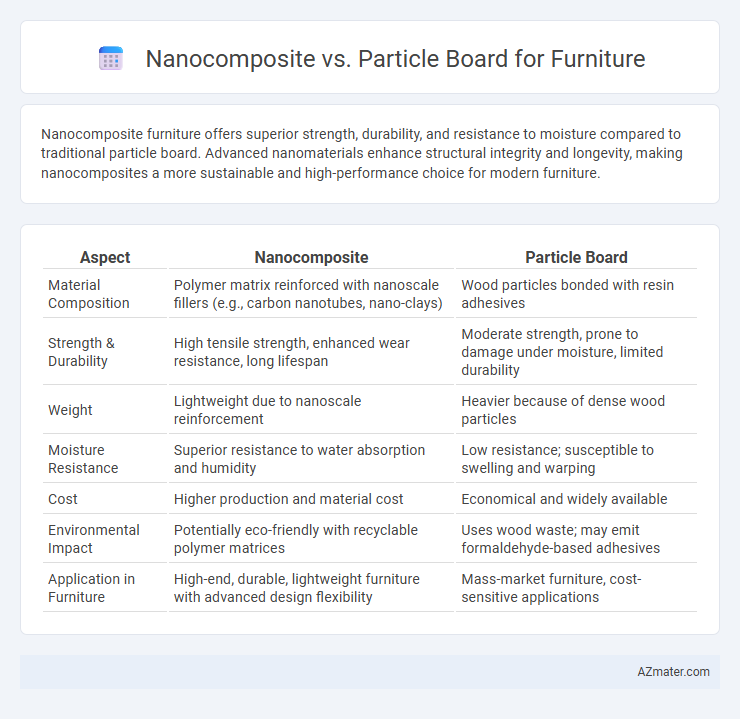Nanocomposite furniture offers superior strength, durability, and resistance to moisture compared to traditional particle board. Advanced nanomaterials enhance structural integrity and longevity, making nanocomposites a more sustainable and high-performance choice for modern furniture.
Table of Comparison
| Aspect | Nanocomposite | Particle Board |
|---|---|---|
| Material Composition | Polymer matrix reinforced with nanoscale fillers (e.g., carbon nanotubes, nano-clays) | Wood particles bonded with resin adhesives |
| Strength & Durability | High tensile strength, enhanced wear resistance, long lifespan | Moderate strength, prone to damage under moisture, limited durability |
| Weight | Lightweight due to nanoscale reinforcement | Heavier because of dense wood particles |
| Moisture Resistance | Superior resistance to water absorption and humidity | Low resistance; susceptible to swelling and warping |
| Cost | Higher production and material cost | Economical and widely available |
| Environmental Impact | Potentially eco-friendly with recyclable polymer matrices | Uses wood waste; may emit formaldehyde-based adhesives |
| Application in Furniture | High-end, durable, lightweight furniture with advanced design flexibility | Mass-market furniture, cost-sensitive applications |
Introduction to Modern Furniture Materials
Nanocomposites offer enhanced mechanical strength, durability, and lightweight properties, making them a cutting-edge alternative to traditional particle board in modern furniture design. Particle board, composed of wood chips and resin, remains cost-effective but lacks the superior resistance to moisture, wear, and impact that nanocomposites provide. The integration of nanomaterials revolutionizes furniture manufacturing by improving performance characteristics while allowing innovative design possibilities.
What Are Nanocomposites?
Nanocomposites are advanced materials created by integrating nanoparticles into a matrix of wood or synthetic polymers, enhancing mechanical strength, durability, and resistance to moisture compared to traditional particle boards. These nanoscale reinforcements improve properties such as thermal stability and surface hardness, making nanocomposite furniture components more resilient and long-lasting. Unlike particle boards, which consist of wood chips bonded by adhesives with limited structural integrity, nanocomposites leverage nanotechnology to surpass conventional material limitations in furniture manufacturing.
Understanding Particle Board Composition
Particle board is primarily composed of wood chips, sawdust, and synthetic resin binders, pressed and heated to form dense panels commonly used in affordable furniture production. Nanocomposites enhance traditional particle board by incorporating nanoparticles such as nanoclays or carbon nanotubes, improving mechanical strength, moisture resistance, and durability. Understanding the base composition of particle board is crucial for evaluating how nanocomposite technology can optimize performance in furniture applications.
Strength and Durability Comparison
Nanocomposite materials exhibit superior strength and durability compared to traditional particle board due to their enhanced molecular structure and uniform nanoparticle dispersion. These nanocomposites resist warping, cracking, and moisture damage far more effectively, making them ideal for high-stress furniture applications. Particle board, while cost-effective, tends to have lower load-bearing capacity and deteriorates faster under environmental stress, limiting its long-term durability.
Weight and Handling Differences
Nanocomposite furniture materials exhibit significantly lower weight compared to traditional particle boards due to the incorporation of nanoscale fillers that enhance strength without bulk. The reduced density of nanocomposites facilitates easier handling and transport, improving ergonomics during manufacturing and assembly processes. Particle boards, being heavier and less rigid, often require more effort to move and manipulate, impacting overall efficiency in furniture production.
Resistance to Moisture and Environmental Factors
Nanocomposites exhibit superior resistance to moisture and environmental factors compared to particle board due to their enhanced polymer matrix reinforced with nanoscale fillers, which reduce water absorption and swelling. Particle board is highly susceptible to moisture damage, leading to warping, swelling, and structural weakening when exposed to humid conditions. The advanced barrier properties of nanocomposites make them ideal for durable furniture applications in environments prone to moisture and temperature fluctuations.
Design Flexibility and Aesthetics
Nanocomposites offer superior design flexibility and aesthetics compared to traditional particle boards due to their enhanced material properties, allowing intricate shapes and smooth finishes. The incorporation of nanoparticles in nanocomposites provides better surface quality, durability, and resistance to wear, resulting in more visually appealing and long-lasting furniture. Particle boards, while cost-effective, typically have limited design options and inferior surface aesthetics, requiring additional finishing to achieve a comparable look.
Cost Analysis: Nanocomposite vs Particle Board
Nanocomposites typically present a higher upfront material cost compared to particle board due to advanced manufacturing processes and enhanced mechanical properties. Particle board remains a cost-effective option for budget-conscious furniture production, offering acceptable durability at a lower price point. Long-term cost analysis, however, favors nanocomposite materials for their superior strength, longevity, and resistance to wear, potentially reducing maintenance and replacement expenses over time.
Sustainability and Environmental Impact
Nanocomposites in furniture offer enhanced sustainability by utilizing advanced materials that improve durability and reduce resource consumption compared to traditional particle board. Particle board production often involves formaldehyde-based adhesives and higher levels of wood waste, contributing to environmental pollution and reduced recyclability. Nanocomposite furniture components demonstrate lower emissions and longer lifespans, supporting eco-friendly practices and minimizing landfill impact.
Best Applications for Each Material
Nanocomposites excel in high-performance furniture applications requiring enhanced strength, durability, and resistance to wear, making them ideal for modern, lightweight designs and premium office or outdoor furniture. Particle board suits budget-friendly, mass-produced furniture such as shelving, cabinets, and flat-pack units where cost efficiency and ease of manufacturing outweigh advanced material properties. Choosing between these materials depends on balancing factors like mechanical performance, environmental exposure, and production cost in the targeted furniture application.

Infographic: Nanocomposite vs Particle board for Furniture
 azmater.com
azmater.com